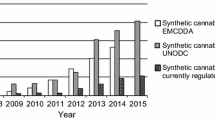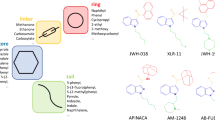Abstract
Police officials brought three different packages of herbal blends, with brand names “AL 37”, “AP 31”, and “GM sapphire”, to our laboratory for drug testing. Using our in-house high-resolution mass spectrometric analysis, we were able to estimate the presence of 5-fluoro-ADB-PINACA and MAB-CHMINACA in them without their reference standards. After obtaining the reference standards, we compared the mass spectra of the extracts of the herbal blends with those of the reference standards using both gas chromatography–mass spectrometry and liquid chromatography–tandem mass spectrometry. The mass spectra of the herbal blend extracts coincided with those of the reference standards, disclosing the presence of 5-fluoro-ADB-PINACA in “AL 37” and “AP 31”, and MAB-CHMINACA in “GM sapphire”. We then quantitated the concentrations of both compounds in the herbal blends using the standard addition method. The concentrations of 5-fluoro-ADB-PINACA were 19.4 ± 0.55 and 19.0 ± 0.47 mg/g (mean ± standard deviation of triplicate determinations) for herbal product brands “AL 37” and “AP 31”, respectively, and that of MAB-CHMINACA was 133 ± 4.5 mg/g for the “GM sapphire” herbal product. To our knowledge, this is the first study to demonstrate the identification and quantitation of the newest synthetic cannabinoids 5-fluoro-ADB-PINACA and MAB-CHMINACA in herbal blend products.







Similar content being viewed by others
References
Uchiyama N, Matsuda S, Wakana D, Kikura-Hanajiri R, Goda Y (2013) New cannabimimetic indazole derivatives, N-(1-amino-3-methyl-1-oxobutan-2-yl)-1-pentyl-1H-indazole-3-carboxamide (AB-PINACA) and N-(1-amino-3-methyl-1-oxobutan-2-yl)-1-(4-fluorobenzyl)-1H-indazole-3- carboxamide (AB-FUBINACA) identified as designer drugs in illegal products. Forensic Toxicol 31:93–100
Uchiyama N, Matsuda S, Kawamura M, Kikura-Hanajiri R, Goda Y (2013) Two new-type cannabimimetic quinolinyl carboxylates, QUPIC and QUCHIC, two new cannabimimetic carboxamide derivatives, ADB-FUBINACA and ADBICA, and five synthetic cannabinoids detected with a thiophene derivative α-PVT and an opioid receptor agonist AH-7921 identified in illegal products. Forensic Toxicol 31:223–240
Uchiyama N, Shimokawa Y, Kawamura M, Kikura-Hanajiri R, Hakamatsuka T (2014) Chemical analysis of a benzofuran derivative, 2-(2-ethylaminopropyl)benzofuran (2-EAPB), eight synthetic cannabinoids, five cathinone derivatives, and five other designer drugs newly detected in illegal products. Forensic Toxicol 32:266–281
Hasegawa K, Wurita A, Minakata K, Gonmori K, Yamagishi I, Nozawa H, Watanabe K, Suzuki O (2015) Identification and quantitation of 5-fluoro-ADB, one of the most dangerous synthetic cannabinoids, in the stomach contents, and solid tissues of a human cadaver, and in some herbal products. Forensic Toxicol 33:112–121
Cayman Chemical (2014) Cayman spectral library. https://www.caymanchem.com/app/template/SpectralLibrary.vm. Accessed Oct 2014
Minakata K, Yamagishi I, Nozawa H, Hasegawa K, Wurita A, Gonmori K, Suzuki M, Watanabe K, Suzuki O (2014) MALDI-TOF mass spectrometric determination of four pyrrolidino cathinones in human blood. Forensic Toxicol 32:169–175
Wurita A, Hasegawa K, Minakata K, Watanabe K, Suzuki O (2014) A large amount of new designer drug diphenidine coexisting with a synthetic cannabinoid 5-fluoro-AB-PINACA found in a dubious herbal product. Forensic Toxicol 32:331–337
Tsujikawa K, Yamamuro T, Kuwayama K, Kanamori T, Iwata YT, Inoue H (2014) Thermal degradation of a new synthetic cannabinoid QUPIC during analysis by gas chromatography–mass spectrometry. Forensic Toxicol 32:201–207
Bonilla E (1978) Flameless atomic absorption spectrophotometric determination of manganese in rat brain and other tissues. Clin Chem 24:471–474
Wurita A, Suzuki O, Hasegawa K, Gonmori K, Minakata K, Yamagishi I, Nozawa H, Watanabe K (2013) Sensitive determination of ethylene glycol, propylene glycol and diethylene glycol in human whole blood by isotope dilution gas chromatography–mass spectrometry, and the presence of appreciable amounts of the glycols in blood of healthy subjects. Forensic Toxicol 31:272–280
Wurita A, Suzuki O, Hasegawa K, Gonmori K, Minakata K, Yamagishi I, Nozawa H, Watanabe K (2014) Presence of appreciable amounts of ethylene glycol, propylene glycol, and diethylene glycol in human urine of healthy subjects. Forensic Toxicol 32:39–44
Wurita A, Suzuki O, Hasegawa K, Gonmori K, Minakata K, Yamagishi I, Nozawa H, Watanabe K (2014) Occurrence of postmortem production of ethylene glycol and propylene glycol in human specimens. Forensic Toxicol 32:162–168
Hasegawa K, Suzuki O, Wurita A, Minakata K, Yamagishi I, Nozawa H, Gonmori K, Watanabe K (2014) Postmortem distribution of α-pyrrolidinovalerophenone and its metabolite in body fluids and solid tissues in a fatal poisoning case measured by LC–MS–MS with the standard addition method. Forensic Toxicol 32:225–234
Hasegawa K, Wurita A, Minakata K, Gonmori K, Nozawa H, Yamagishi I, Suzuki O, Watanabe K (2014) Identification and quantitation of a new cathinone designer drug PV9 in an “aroma liquid” product, antemortem whole blood and urine specimens, and a postmortem whole blood specimen in its fatal poisoning case. Forensic Toxicol 32:243–250
Wurita A, Hasegawa K, Minakata K, Gonmori K, Nozawa H, Yamagishi I, Suzuki O, Watanabe K (2014) Postmortem distribution of α-pyrrolidinobutiophenone in body fluids and solid tissues of a human cadaver. Leg Med 16:241–246
Conflict of interest
There are no financial or other relationships that could lead to a conflict of interest.
Author information
Authors and Affiliations
Corresponding author
Additional information
A. Wurita and K. Hasegawa contributed equally to this work.
Rights and permissions
About this article
Cite this article
Wurita, A., Hasegawa, K., Minakata, K. et al. Identification and quantitation of 5-fluoro-ADB-PINACA and MAB-CHMINACA in dubious herbal products. Forensic Toxicol 33, 213–220 (2015). https://doi.org/10.1007/s11419-015-0264-y
Received:
Accepted:
Published:
Issue Date:
DOI: https://doi.org/10.1007/s11419-015-0264-y




